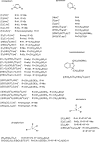The use of supported acidic ionic liquids in organic synthesis
- PMID: 24972271
- PMCID: PMC6271805
- DOI: 10.3390/molecules19078840
The use of supported acidic ionic liquids in organic synthesis
Abstract
Catalysts obtained by the immobilisation of acidic ionic liquids (ILs) on solid supports offer several advantages compared to the use of catalytically active ILs themselves. Immobilisation may result in an increase in the number of accessible active sites of the catalyst and a reduction of the amount of the IL required. The ionic liquid films on the carrier surfaces provide a homogeneous environment for catalytic reactions but the catalyst appears macroscopically as a dry solid, so it can simply be separated from the reaction mixture. As another advantage, it can easily be applied in a continuous fixed bed reactor. In the present review the main synthetic strategies towards the preparation of supported Lewis acidic and Brønsted acidic ILs are summarised. The most important characterisation methods and structural features of the supported ionic liquids are presented. Their efficiency in catalytic reactions is discussed with special emphasis on their recyclability.
Conflict of interest statement
The author declares no conflict of interest.
Figures













































Similar articles
-
Lewis Acidic Ionic Liquids.Top Curr Chem (Cham). 2017 Aug 21;375(5):78. doi: 10.1007/s41061-017-0166-z. Top Curr Chem (Cham). 2017. PMID: 28828725 Free PMC article. Review.
-
Lewis acid organocatalysts.Top Curr Chem. 2010;291:349-93. doi: 10.1007/978-3-642-02815-1_17. Top Curr Chem. 2010. PMID: 21494948 Review.
-
Supported Ionic Liquids and their Applications in Organic Transformations.Curr Org Synth. 2022;19(8):905-922. doi: 10.2174/1570179419666220303110933. Curr Org Synth. 2022. PMID: 36267047 Review.
-
Efficient Lewis acid ionic liquid-catalyzed synthesis of the key intermediate of coenzyme Q10 under microwave irradiation.Molecules. 2010 Dec 22;15(12):9486-95. doi: 10.3390/molecules15129486. Molecules. 2010. PMID: 21178903 Free PMC article.
-
The Synthesis and Application of Ionic Liquid Functionalized Mesoporous Silica SBA-15 for Organic Synthesis.Curr Org Synth. 2022;19(8):874-904. doi: 10.2174/1570179419666220329161233. Curr Org Synth. 2022. PMID: 35352650
Cited by
-
Tuning the acidity of halloysite by polyionic liquid to develop an efficient catalyst for the conversion of fructose to 5-hydroxymethylfurfural.Sci Rep. 2023 May 11;13(1):7663. doi: 10.1038/s41598-023-34876-4. Sci Rep. 2023. PMID: 37169952 Free PMC article.
-
Multi-Component Syntheses of Spiro[furan-2,3'-indoline]-3-carboxylate Derivatives Using Ionic Liquid Catalysts.Molecules. 2024 Mar 8;29(6):1223. doi: 10.3390/molecules29061223. Molecules. 2024. PMID: 38542860 Free PMC article.
-
Aerobic Oxidative Desulfurization by Supported Polyoxometalate Ionic Liquid Hybrid Materials via Facile Ball Milling.Molecules. 2024 Mar 29;29(7):1548. doi: 10.3390/molecules29071548. Molecules. 2024. PMID: 38611826 Free PMC article.
-
Synthesis and Properties of Magnetic Aryl-Imidazolium Ionic Liquids with Dual Brønsted/Lewis Acidity.Materials (Basel). 2018 Dec 13;11(12):2539. doi: 10.3390/ma11122539. Materials (Basel). 2018. PMID: 30551622 Free PMC article.
-
Supported Ionic Liquid Phase Catalysts Dedicated for Continuous Flow Synthesis.Materials (Basel). 2023 Mar 5;16(5):2106. doi: 10.3390/ma16052106. Materials (Basel). 2023. PMID: 36903221 Free PMC article. Review.
References
-
- Wilson K., Clark J.H. Solid acids and their use as environmentally friendly catalysts in organic synthesis. Pure Appl. Chem. 2000;72:1313–1319.
-
- Hajipour A.R., Rafiee F. Acidic bronsted ionic liquids. Org. Prep. Proc. Int. 2010;42:285–362. doi: 10.1080/00304948.2010.490177. - DOI
-
- Lin I.J.B., Vasam C.S. Metal-containing ionic liquids and ionic liquid crystals based on imidazolium moiety. J. Organomet. Chem. 2005;690:3498–3512. doi: 10.1016/j.jorganchem.2005.03.007. - DOI
-
- Chiappe C., Rajamani S. Structural effects on the physico-chemical and catalytic properties of acidic ionic liquids: An overview. Eur. J. Org. Chem. 2011;28:5517–5539. doi: 10.1002/ejoc.201100432. - DOI
Publication types
MeSH terms
Substances
LinkOut - more resources
Full Text Sources
Other Literature Sources
Research Materials

